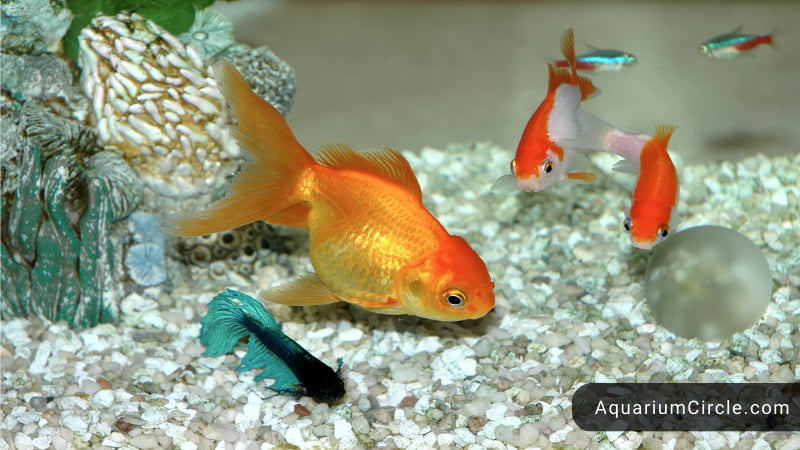Goldfish are popular household pets, known for their bright colors, interesting personalities, and adaptability to life in a tank. While many people enjoy observing their goldfish swimming around, some may have noticed that their fish are often found sitting or lying on the bottom of the tank. This behavior can be concerning for pet owners and may lead to questions about the health of their fish, such as “why goldfish laying on bottom of tank?”, “is it normal for them to sit on the bottom?” In this article, we will explore the reasons why goldfish may sit at the bottom of the tank and what can be done to address this issue.
See also:
- Betta Fish Laying On Side: Top 13 Vital Reasons You Should Beware
- Top 3 Reasons Why The Cory Catfish Laying On Side
- Goldfish Nitrate Poisoning: How To Avoid & 7 Cures (in Short And Long Term)
Can Stress Make Goldfish Lay On The Bottom Of The Tank?
Yes, stress can definitely cause a goldfish to lay at the bottom of its tank. Goldfish are social animals and do best in environments that are peaceful, clean, and properly maintained. If a goldfish is kept in a tank that is too small, overcrowded, or not properly maintained, it can become stressed and unhealthy, leading to a variety of problems, including loss of appetite, lethargy, and a tendency to lay at the bottom of the tank.
In addition to environmental stress, your fish may also become stressed due to changes in their routine, such as being moved to a new tank, being introduced to new tank mates, or experiencing sudden changes in water temperature. Stress can weaken a goldfish’s immune system, making it more susceptible to illness and disease, and it can also affect its behavior and overall health.
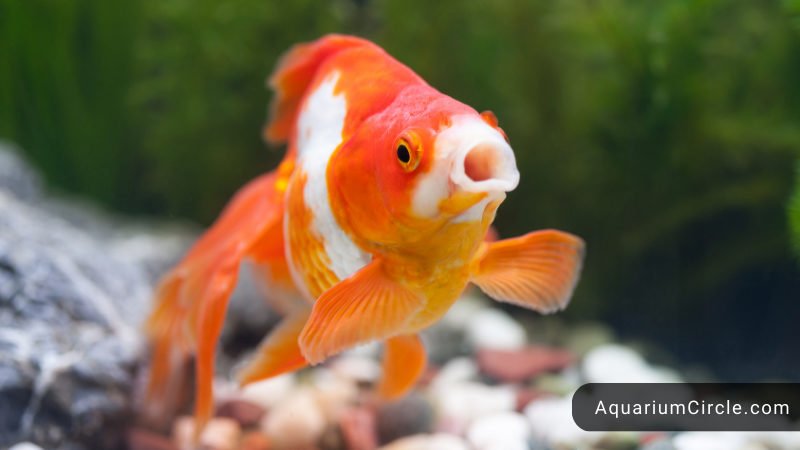
To prevent stress in goldfish, it’s important to provide them with a spacious and well-maintained tank that is appropriately sized for their needs. Regular water changes, proper filtration, and careful monitoring of water quality can also help to reduce stress in goldfish. Additionally, it’s important to provide plenty of hiding places and toys to help keep your goldfish active and engaged, and to avoid overfeeding and sudden changes in its environment.
If you suspect that your goldfish is stressed, it’s a good idea to take action as soon as possible to address the underlying cause and to provide the necessary treatment. In many cases, reducing stress and improving the quality of the goldfish’s environment can help to alleviate the symptoms and improve its overall health. However, if your goldfish is showing signs of illness or disease, it’s always a good idea to consult with a veterinarian, who can help you diagnose the problem and recommend the best course of treatment.
How Tank Size Affect On Goldfish Laying On Bottom Of The Tank?
Tank size can play a significant role in whether or not a goldfish is laying at the bottom of its tank. Goldfish are active, social creatures that require a lot of space to swim, explore, and thrive. If they are kept in a tank that is too small, they can become stressed and unhappy, which can lead to a variety of health problems, including a tendency to lay at the bottom of the tank.
Goldfish can grow quite large and can reach lengths of up to 18 inches or more, so it’s important to make sure that the tank is appropriately sized for their needs. As a general rule, it’s recommended that goldfish be kept in a tank that provides at least 20 gallons of water per fish. This will help to ensure that they have enough space to swim and explore, and that the water quality remains stable and healthy.
In addition to tank size, it’s also important to make sure that the tank is properly maintained and cleaned regularly. Poor water quality can cause stress and health problems in goldfish, so it’s important to use a good quality filtration system, perform regular water changes, and keep the tank free of excess waste and debris.
If you’re having trouble keeping your goldfish healthy and happy, it’s a good idea to consult with a veterinarian or an experienced fish keeper who can help you diagnose the problem and recommend the best course of action. By providing your goldfish with a spacious and well-maintained tank, along with plenty of hiding places and toys, you can help to ensure that it remains happy and healthy for many years to come.
Does Water Conditions Matter?
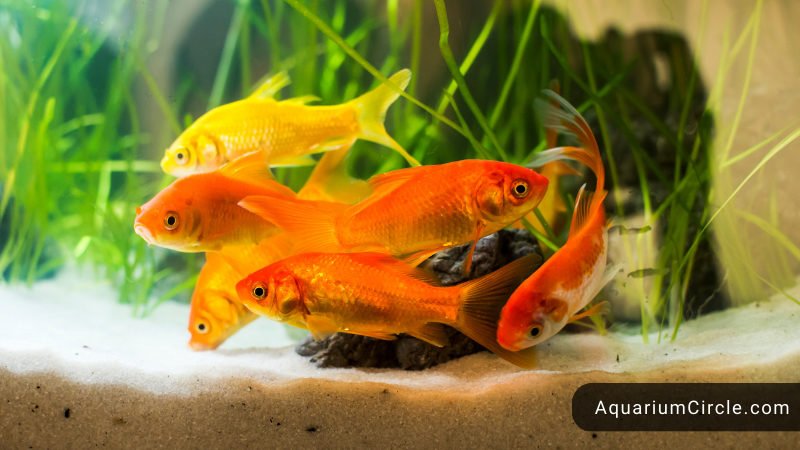
Yes, water conditions play a critical role in the health and behavior of goldfish, and poor water conditions can definitely contribute to them sink to the bottom of their aquarium. Goldfish are very sensitive to changes in their environment, and even minor changes in water quality can cause the fish stress and illness.
Some of the key water conditions that can affect goldfish include:
- Water temperature: Goldfish are cold-water fish, and they do best in water that is between 65°F and 75°F. If the water temperature becomes too high or too low, it can cause stress and illness in goldfish, leading to a tendency to lay at the bottom of the tank.
- Water hardness: Goldfish do best in water that has a moderate level of hardness. If the water is too soft or too hard, it can cause stress and illness in goldfish, leading to a tendency to lay at the bottom of the tank.
- Water pH: Goldfish prefer water that has a pH level between 7.0 and 8.0. If the pH level becomes too low or too high, it can cause stress and illness in goldfish, leading to a tendency to lay at the bottom of the tank.
- Water quality: Goldfish are highly sensitive to changes in water quality, and poor water quality can cause stress and illness in goldfish. It’s important to perform regular water changes and to use a good quality filtration system to keep the water in your goldfish tank clean and healthy.
- Toxins: Certain toxins, such as ammonia, nitrite, and nitrate, can build up in the water and cause stress and illness in goldfish, leading to a tendency to lay at the bottom of the tank. It’s important to monitor water quality regularly and to perform regular water changes to keep these toxins at safe levels.
To ensure that your goldfish remains healthy and happy, it’s important to maintain the water conditions in your tank carefully, and to make sure that the water quality remains stable and healthy. Regular water testing can help you to identify any problems early on and to take the necessary steps to address them. If you’re having trouble keeping your goldfish healthy and happy, it’s a good idea to consult with a veterinarian or an experienced fish keeper who can help you diagnose the problem and recommend the best course of action.
Disease: Which Disease Can Make Your Goldfish Lay At The Bottom?
Disease is another factor that can contribute to goldfish laying at the bottom of their tank. Goldfish are susceptible to a variety of diseases, many of which can be caused by stress, poor water quality, or other environmental factors. Some of the most common diseases that can affect goldfish include:
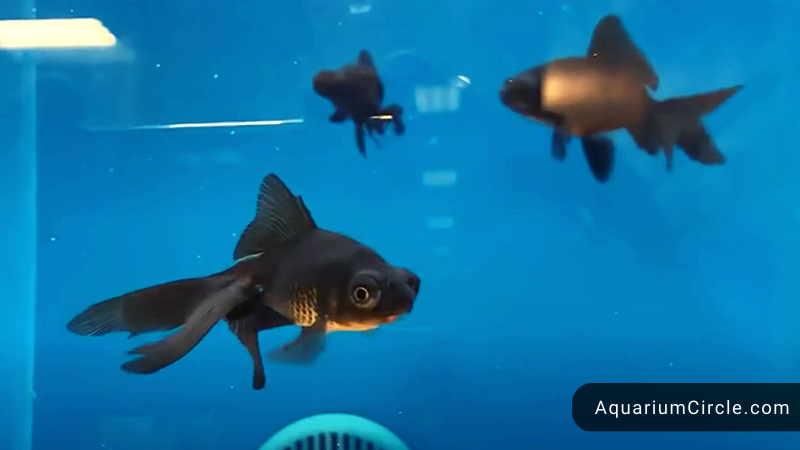
Of the various diseases that can affect goldfish, swim bladder disease is one of the most likely to cause a fish to lay at the bottom of the tank. Swim bladder disease is a condition that affects the swim bladder, a gas-filled organ that helps a fish to maintain its balance and stability in the water. When a fish has swim bladder disease, it may have trouble swimming to the surface for air, or it may swim awkwardly or lay at the bottom of your tank.
Swim bladder disease can be caused by a variety of factors, including genetics, poor water quality, injury, parasites, and an unhealthy diet. Symptoms of swim bladder disease can include:
- Swimming abnormally or having trouble maintaining balance
- Laying at the tank’s bottom
- Floating upside down or on its side
- Having trouble swimming to the surface for air
If you suspect that your goldfish is suffering from swim bladder disease or any of diseases that have been mentioned above, it’s important to seek veterinary care as soon as possible to help prevent the spread of the infection and to ensure the best possible outcome for your fish. Your veterinarian or a fish expert can diagnose the problem and recommend the best course of action, which may include antibiotics, changes to the water conditions, or a change in diet.
Can Ammonia Levels Make Goldfish Sit At The Bottom Of The Aquarium?
Yes, high levels of ammonia in the water can cause goldfish to suffer and may result in them laying at the bottom of the tank. Ammonia is a toxic substance that can build up in an aquarium as a result of fish waste, uneaten food, and decaying organic matter. High levels of ammonia can cause serious health problems for goldfish, including damage to their gills, skin, and eyes.
If a goldfish is exposed to high levels of ammonia, it may display symptoms such as:
- Sick goldfish staying at the bottom of the tank
- Rapid gill movement
- Clamped fins
- Loss of appetite
- Lesions or sores on the skin
- Swimming abnormally or having trouble maintaining balance
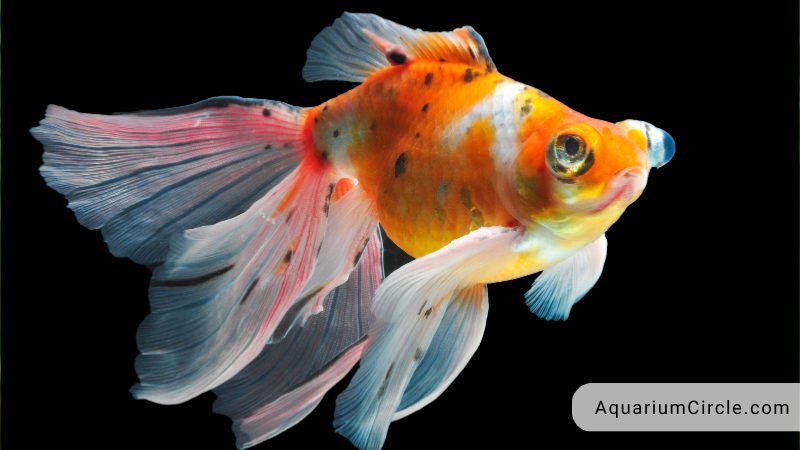
It’s important to regularly test the water in your goldfish’s tank to make sure that the levels of ammonia are within a safe range. If you notice that the levels of ammonia are too high, there are several steps you can take to lower them, including:
- Doing regular water changes to dilute the levels of ammonia in the water
- Adding a water conditioner that removes ammonia
- Installing a high-quality filter system to help remove waste and other harmful substances from the water
- Feeding your goldfish smaller, more frequent meals to reduce the amount of waste they produce
If you suspect that your goldfish is suffering from high levels of ammonia, it’s important to seek veterinary care as soon as possible to help prevent the spread of the infection and to ensure the best possible outcome for your fish. Your veterinarian or a fish expert can diagnose the problem and recommend the best course of action, which may include changes to the water conditions, a change in diet, or the use of water conditioners or other treatments.
When Getting Bored, Is Goldfish Laying On Bottom Of Tank?
Goldfish are not typically thought to get bored, but a lack of stimulation or environmental enrichment can lead to behavior changes, such as staying at the bottom of the tank. Fish, like all animals, need to be in an environment that meets their physical and behavioral needs in order to thrive.
In an aquarium setting, this means providing a suitable environment for the fish to live in, including plenty of swimming space, adequate filtration, and appropriate water conditions. It also means providing them with adequate stimulation and environmental enrichment to keep them healthy and active.
For goldfish, this can include:
- Adding decorations or hiding places to the tank
- Providing a varied diet with live or frozen food options
- Changing up the tank’s layout or adding new decorations every so often
- Offering interactive toys or feeding devices to increase their physical and mental stimulation
If a goldfish does not have enough stimulation and environmental enrichment, it may become inactive and spend more time at the bottom of the tank. This can lead to health problems and a decreased quality of life for the fish. To avoid this, it’s important to provide your goldfish with a healthy and stimulating environment that meets their needs.
They Are Sleeping
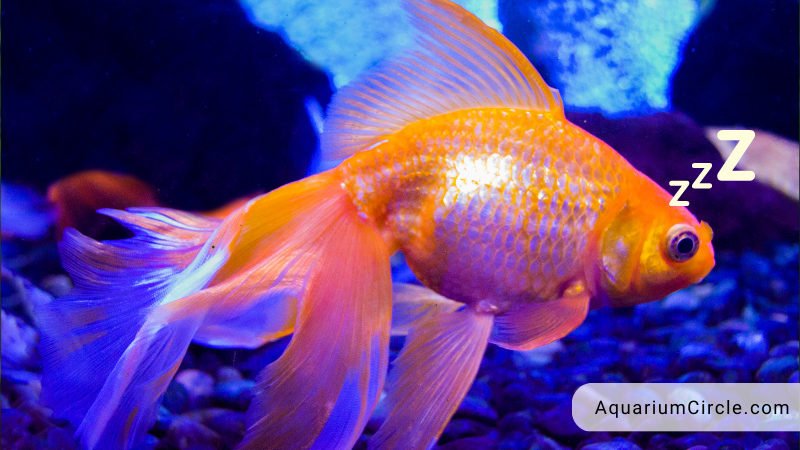
Goldfish do sleep, but they are not like mammals that close their eyes and fall into a deep slumber. Instead, they enter a state of rest where they become less active and may spend more time resting on the bottom of the tank. This state of rest is important for the fish’s overall health and well-being, as it allows them to conserve energy and rejuvenate their bodies.
During this rest period, goldfish will typically slow down their swimming, stop feeding, and become more still. They may also become less responsive to their surroundings, appearing as if they are in a state of deep sleep.
It’s important to note that there is a difference between a goldfish that is resting and a goldfish that is sick or stressed. If a goldfish is laying at the bottom of the tank and appears to be inactive for an extended period of time, it’s important to check for other symptoms of illness or stress, such as changes in swimming behavior, loss of appetite, or the presence of visible sores or wounds. If you are concerned about the health of your goldfish, it’s best to seek veterinary care as soon as possible to ensure the best possible outcome for your fish.
They Have Passed Away
When goldfish die, they will typically float on the surface of the water. When a fish dies, it loses its ability to maintain buoyancy, and it will no longer have the ability to swim. As a result, the fish will float to the surface of the water, where it will typically remain until it is removed.
In some cases, a dead fish may sink to the bottom of the tank, particularly if it has become bloated or if it has been dead for some time. However, floating is the most common way that dead fish will be found in an aquarium.
If you suspect that a fish has died, it’s important to remove it from the tank as soon as possible to prevent the spread of any diseases or parasites. Additionally, dead fish can release toxins into the water, which can harm other fish in the tank, so it’s important to act quickly to minimize any impact on the remaining fish in the aquarium.
See also: Why Do Goldfish Die So Fast? – Here Are 7 Reasons Why!
Video About Goldfish Laying On Bottom Of Tank
Conclusion
In conclusion, goldfish can spend time at the bottom of the tank for a variety of reasons, including illness, stress, water conditions, and a lack of stimulation. Some common diseases that can cause goldfish to lay at the bottom of the tank include swim bladder disorder, bacterial infections, and parasitic infections. Stress can be caused by factors such as poor water conditions, overcrowding, and a lack of environmental enrichment.
To ensure that your goldfish are healthy and happy, it’s important to provide them with a suitable environment that meets their physical and behavioral needs. This includes regular water changes, adequate filtration, and appropriate water conditions, as well as environmental enrichment in the form of decorations, interactive toys, and a varied diet. If you suspect that your goldfish is ill or stressed, it’s best to seek veterinary care as soon as possible to ensure the best possible outcome for your fish.
By understanding the reasons why goldfish lay at the bottom of the tank and taking steps to provide them with a healthy environment, you can help your fish to thrive and enjoy a long and happy life in your aquarium.

Annette M. Chaney is an experienced marine biologist with over 20 years of experience as an aquarist and fishkeeper. She started her first aquarium at a young age, filling it with frogs and goldfish obtained from the ten-cent pet store.
Annette grew up caring for and breeding African Cichlids, which led to a hobby in high school that doubled as a profitable means. Attending Reed College gave her time to solidify herself as an accomplished aquarium caretaker with an eye for sales. After that, from 2009 – 2013, she studied at Roger Williams University – one of the most prestigious universities for Aquaculture and Aquarium in USA. She is the founder of AquariumCircle since 2010.
